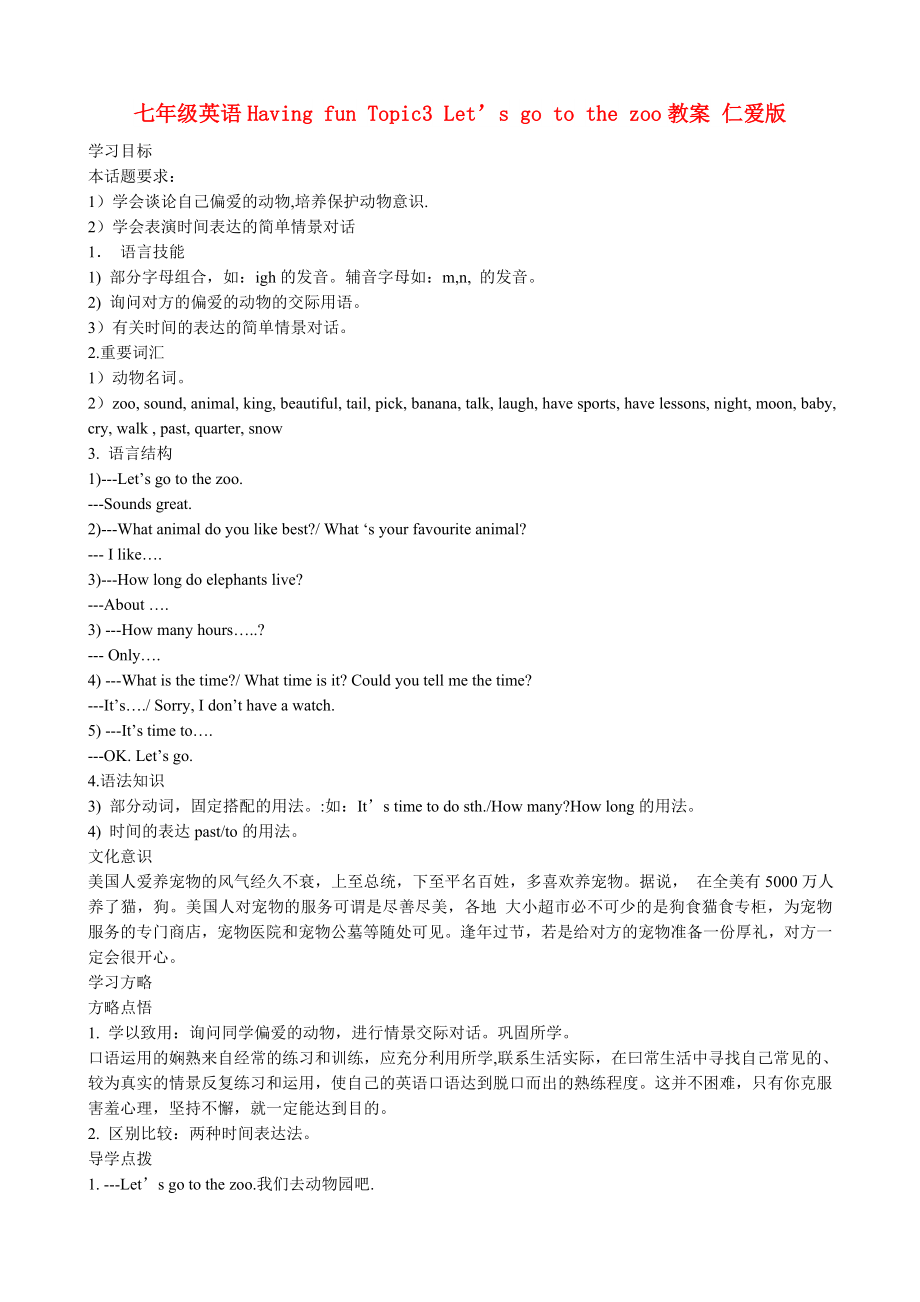《七年級英語Having fun Topic3 Let’s go to the zoo教案 仁愛版》由會員分享���,可在線閱讀��,更多相關(guān)《七年級英語Having fun Topic3 Let’s go to the zoo教案 仁愛版(4頁珍藏版)》請?jiān)谘b配圖網(wǎng)上搜索���。
1�����、七年級英語Having fun Topic3 Let’s go to the zoo教案 仁愛版
學(xué)習(xí)目標(biāo)
本話題要求:
1)學(xué)會談?wù)撟约浩珢鄣膭游?培養(yǎng)保護(hù)動物意識.
2)學(xué)會表演時(shí)間表達(dá)的簡單情景對話
1. 語言技能
1) 部分字母組合,如:igh的發(fā)音�。輔音字母如:m,n, 的發(fā)音����。
2) 詢問對方的偏愛的動物的交際用語。
3)有關(guān)時(shí)間的表達(dá)的簡單情景對話�����。
2.重要詞匯
1)動物名詞。
2)zoo, sound, animal, king, beautiful, tail, pick, banana, talk, laugh, have sports, have
2�����、 lessons, night, moon, baby, cry, walk , past, quarter, snow
3. 語言結(jié)構(gòu)
1)---Let’s go to the zoo.
---Sounds great.
2)---What animal do you like best?/ What ‘s your favourite animal?
--- I like….
3)---How long do elephants live?
---About ….
3) ---How many hours…..?
--- Only….
4) ---What is th
3���、e time?/ What time is it? Could you tell me the time?
---It’s…./ Sorry, I don’t have a watch.
5) ---It’s time to….
---OK. Let’s go.
4.語法知識
3) 部分動詞,固定搭配的用法。:如:It’s time to do sth./How many?How long的用法����。
4) 時(shí)間的表達(dá)past/to的用法���。
文化意識
美國人愛養(yǎng)寵物的風(fēng)氣經(jīng)久不衰���,上至總統(tǒng),下至平名百姓����,多喜歡養(yǎng)寵物���。據(jù)說���, 在全美有5000萬人養(yǎng)了貓�����,狗��。美國人對寵物的服務(wù)可謂
4�����、是盡善盡美��,各地 大小超市必不可少的是狗食貓食專柜����,為寵物服務(wù)的專門商店�����,寵物醫(yī)院和寵物公墓等隨處可見���。逢年過節(jié)��,若是給對方的寵物準(zhǔn)備一份厚禮��,對方一定會很開心��。
學(xué)習(xí)方略
方略點(diǎn)悟
1. 學(xué)以致用:詢問同學(xué)偏愛的動物�,進(jìn)行情景交際對話����。鞏固所學(xué)。
口語運(yùn)用的嫻熟來自經(jīng)常的練習(xí)和訓(xùn)練�,應(yīng)充分利用所學(xué),聯(lián)系生活實(shí)際���,在曰常生活中尋找自己常見的�、較為真實(shí)的情景反復(fù)練習(xí)和運(yùn)用�,使自己的英語口語達(dá)到脫口而出的熟練程度�����。這并不困難����,只有你克服害羞心理,堅(jiān)持不懈�����,就一定能達(dá)到目的���。
2. 區(qū)別比較:兩種時(shí)間表達(dá)法���。
導(dǎo)學(xué)點(diǎn)撥
1. ---Let’s go to the zoo.我們?nèi)游飯@
5、吧.
---Sounds great. 聽起來棒極了.
Sounds great.是It sounds great的省略句. Sound連系動詞,可直接修飾形容詞...
2---What animals do you like best? 你最喜歡什么動物?
--- I like elephants. 我最喜歡大象.
1)What animals do you like best? 也可說: What’s your favourite animal?
2)Like… best.如:
I like peacocks best.我最喜歡孔雀.
I like English bes
6��、t. 我最喜歡英語.
3. Maria and Kangkang are going to the zoo. 瑪麗婭與康康要去動物園.
be going to do sth. 要做某事, 表示將要發(fā)生的事情.如:
They are going to have a picnic.
4. On the bus 在公共汽車上
5. They are talking about different animals in the zoo. They are too excited to see the animals.他們談?wù)撝鴦游飯@里不同的動物.他們看見動物時(shí)很激動.
1) talk
7����、about談?wù)?如:They are talking about the weather.他們正在談?wù)撎鞖? talk to/ talk with sb.與某人交談;如:
She’s talking with/to her boy friend.她正與她的男朋友交談.
2) be excited to do sth.做某事很興奮.如:
We are glad to see you. 見到你我們很高興.
She’s happy to see her mother. 見到媽媽她很高興.
6. How long do elephants live?大象能或多久?
How long 多長
8�����、時(shí)間,多長;如:
How long will you stay here? 你會呆在這兒多久?
How long is Nandu River? 南渡江有多長?
How long is your ruler? 你的尺子有多長?
7 . How many hours do elephants sleep at night?大象晚上睡幾個(gè)小時(shí)?
how many “多少,幾; “修飾不可數(shù)名詞,how many+可數(shù)名詞復(fù)數(shù);如:
How many books do you have? 你有多少本書?
How many photos can you see?你能看到幾張相片?
H
9、ow many bags are there on the desk? 課桌上有幾個(gè)書包?
how much”多少,多少錢,”修飾不可數(shù)名詞; how much+ 不可數(shù)名詞,如:
How much water is there in the bottle? 瓶子里有多少水?
注意:How much is this book?是什么意思呢?
8. .at night 在晚上
9. ---What time is it now? 現(xiàn)在幾點(diǎn)了?
--- It’s six o’clock. 六點(diǎn).
What time is it now?可說為: what’s the time? It
10��、’s six o’clock. 可說為:It’s six. 如:
It’s ten o’clock.=It’s ten..
10. It’s time to go home. 到時(shí)間回家了.
1)It’s time to do sth. “到……的時(shí)候了.是該做……了.”與It’s time for sth.同義.如:
It’s time to have breakfast. =It’s time for breakfast. 該吃早餐了.
2)It’s time for sb. to do sth. 某人該做某事了.如:
It’s time for us to go to bed
11���、..我們該上床睡覺了.
It’s time for you to go home. 我們該回家了
It’s有時(shí)可省;如:
Time for supper. 該吃晚飯了��。
Time to go to sleep. 該睡覺了����。
11. It’s a five past one =It’s one-o-five. 一點(diǎn)五分.
It’s a quarter past one =It’s one fifteen.一點(diǎn)十五分(一點(diǎn)過一刻)
It’s half past one.=It’s one thirty.一點(diǎn)半
It’s twenty to two.= It’s one forty.
12、 一點(diǎn)四十分
It’s a quarter to two. =It’s one forty-five一點(diǎn)四十五分(差一刻到兩點(diǎn))
一刻 時(shí)刻表達(dá)法有直接與間接表達(dá)兩種.
1)直接表達(dá),如:
4:10 four ten
12:50 twelve fifty
2:30 two thirty
2)間接表達(dá).有兩種情況; 半小時(shí)前用 pasr 意思為“過” 半小時(shí)后用to意思為”差”; 如:
4:10 ten past four (四點(diǎn)過十分)
4:15 a quarter past four (四點(diǎn)過一刻)
4;30 half past four
4:40 twenty to
13�����、five (差二十分到五點(diǎn))
4:45 a quarter to five (差一刻到五點(diǎn))
試比較:
It’s three o’clock.= It’s three.
It’s ten to ten. It’s ten past ten.
It’s a quarter past three. It’s a quarter to three.
12. Excuse me. 打攪,對不起
在學(xué)習(xí)運(yùn)用英語曰常交際用語時(shí)���,要注意英語的語言習(xí)慣和語言情景�,不可只根據(jù)中文的意思使用。如�,本話題所學(xué)的Excuse me中文可翻譯為“對不起”,但它跟Sorry的“對不起”意義卻很不一樣:當(dāng)
14�����、我們的錯(cuò)誤言行給別人帶來麻煩時(shí),我們的“對不起”是Sorry�;而我們要打擾別人時(shí)的“對不起”則是Excuse me���。
---Excuse me, where is the hospital? 請問,醫(yī)院怎么走?
---I am sorry , I don’t know. 對不起,我不知道.
13. I have no watch.意為: I don’t have a watch. .No =not a或 not any;如:
She has no brothers.= She doesn’t have any brothers. 她沒有兄弟.
14. Could you tell m
15���、e the time, please?你能告訴我?guī)c(diǎn)了嗎?
Could you tell me…?你能告訴我……?
Could you tell me you phone number? 能告訴我你的電話號碼嗎?
15. Let me help you. 讓我?guī)湍?
Let后用賓格.如:
Let him help us. 讓他幫我們.
16. What’s wrong with you? 你怎么了?可說為What’s the matter with you? /What is the trouble with you? /What’s up?
17. I am lost. I c
16、an’t find my way home. 我迷路了.我找不到回家的路.
意思為”能夠”,情態(tài)動詞,應(yīng)修飾動詞原形:can +動詞原形,如:
I can sing. 我能唱歌..
He can’t swim. 他不能游泳
18. It’s very kind of you to help us. 你太好了,能幫我們.
It’s kind of sb. to do sth. 致謝的一種表達(dá)方式.同義為:
It’s very nice of you to help us.
19. Could you please pass me a banana? 你能把香蕉遞給我嗎?
pass sb. sth. =pass sth to sb. 把某物遞給某人,如:
Please pass me your book=Please pass your book to me.
把你的課本遞給我.
類似的有:
give sb. sth.= Give sth to sb.
 七年級英語Having fun Topic3 Let’s go to the zoo教案 仁愛版
七年級英語Having fun Topic3 Let’s go to the zoo教案 仁愛版

